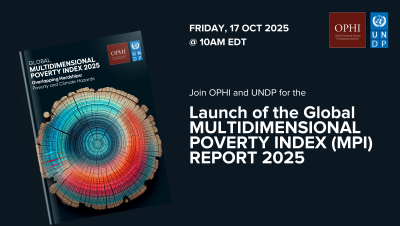2025 Global Multidimensional Poverty Index (MPI)
Overlapping Hardships: Poverty and Climate Hazards

UNDP (United Nations Development Programme). 2025. 2025 Global Multidimensional Poverty Index (MPI): Overlapping Hardships: Poverty and Climate Hazards. New York.
2025 Global Multidimensional Poverty Index (MPI)
Overlapping Hardships: Poverty and Climate Hazards
This 2025 Global Multidimensional Poverty Index (MPI) report, for the first time, overlays data on climate hazards and multidimensional poverty to assess how exposed poor people are to environmental shocks. The report highlights that most people in poverty are exposed to at least one climate hazard; many confront several at the same time. By the end of this century, the countries projected to face the steepest temperature increases are those already burdened with higher levels of multidimensional poverty.
This year’s update of the global MPI database includes new data from 13 countries. It presents MPI data from 109 countries, along with subnational estimates covering 1,359 regions across 101 countries. The results show that 1.1 billion of 6.3 billion people live in acute multidimensional poverty, over half of them children. Common deprivations include a lack of clean cooking fuel, housing, sanitation, nutrition, and electricity.
The intertwining of climate and poverty risks is likely to intensify in the future, and the report makes a compelling case for addressing a double burden that may only worsen.
Key Findings (2025)
1.1b
People live in Multidimensional Poverty
740m
Poor population live in middle-income countries
887m
Poor people are exposed to at least one of four climate hazards
309m
Poor people face three or four concurrent hazards
MPI Indicators
| Dimensions of Poverty | Indicator | Deprived if living in the household where… | Weight |
|---|---|---|---|
| Health | Nutrition | Any adult under 70 years of age or any child for whom there is nutritional information is undernourished. | 1/6 |
| Child mortality | Any child under the age of 18 years has died in the family in the five-year period preceding the survey. | 1/6 | |
| Education | Years of schooling | No household member aged ‘school entrance age + six years or older has completed at least six years of schooling. | 1/6 |
| School attendance | Any school-aged child is not attending school up to the age at which he/she would complete class eight. | 1/6 | |
| Standard of living | Cooking fuel | The household cooks with dung, wood, charcoal or coal. | 1/18 |
| Sanitation | The household’s sanitation facility is not improved (according to SDG guidelines) or it is improved but shared with other households. | 1/18 | |
| Drinking water | The household does not have access to improved drinking water (according to SDG guidelines) or improved drinking water is at least a 30-minute walk from home, round trip. | 1/18 | |
| Electricity | The household has no electricity. | 1/18 | |
| Housing | At least one of the three housing materials for roof, walls and floor are inadequate: the floor is of natural materials and/or the roof and/or walls are of natural or rudimentary materials. | 1/18 | |
| Assets | The household does not own more than one of these assets: radio, television, telephone, computer, animal cart, bicycle, motorbike or refrigerator, and does not own a car or truck. | 1/18 |
